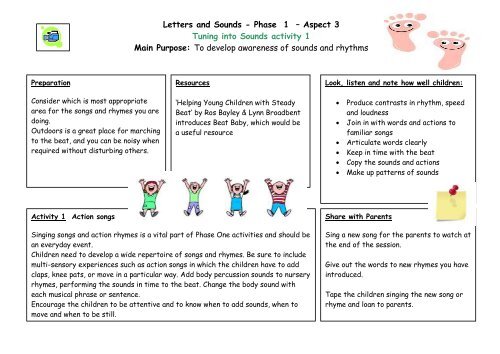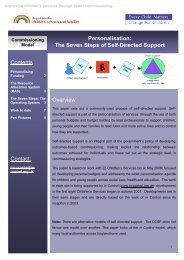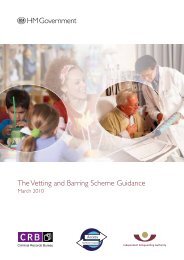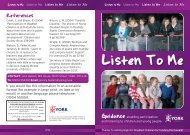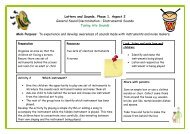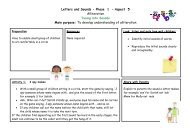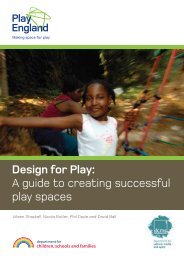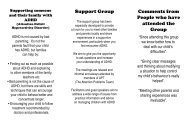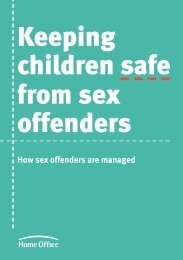Letters and Sounds - Phase 1 – Aspect 3 Tuning into Sounds activity ...
Letters and Sounds - Phase 1 – Aspect 3 Tuning into Sounds activity ...
Letters and Sounds - Phase 1 – Aspect 3 Tuning into Sounds activity ...
- No tags were found...
Create successful ePaper yourself
Turn your PDF publications into a flip-book with our unique Google optimized e-Paper software.
<strong>Letters</strong> <strong>and</strong> <strong>Sounds</strong> - <strong>Phase</strong> 1 – <strong>Aspect</strong> 3<br />
<strong>Tuning</strong> <strong>into</strong> <strong>Sounds</strong> <strong>activity</strong> 1<br />
Main Purpose: To develop awareness of sounds <strong>and</strong> rhythms<br />
Preparation<br />
Resources<br />
Look, listen <strong>and</strong> note how well children:<br />
Consider which is most appropriate<br />
area for the songs <strong>and</strong> rhymes you are<br />
doing.<br />
Outdoors is a great place for marching<br />
to the beat, <strong>and</strong> you can be noisy when<br />
required without disturbing others.<br />
‘Helping Young Children with Steady<br />
Beat’ by Ros Bayley & Lynn Broadbent<br />
introduces Beat Baby, which would be<br />
a useful resource<br />
<br />
<br />
<br />
<br />
<br />
<br />
Produce contrasts in rhythm, speed<br />
<strong>and</strong> loudness<br />
Join in with words <strong>and</strong> actions to<br />
familiar songs<br />
Articulate words clearly<br />
Keep in time with the beat<br />
Copy the sounds <strong>and</strong> actions<br />
Make up patterns of sounds<br />
Activity 1 Action songs<br />
Singing songs <strong>and</strong> action rhymes is a vital part of <strong>Phase</strong> One activities <strong>and</strong> should be<br />
an everyday event.<br />
Children need to develop a wide repertoire of songs <strong>and</strong> rhymes. Be sure to include<br />
multi-sensory experiences such as action songs in which the children have to add<br />
claps, knee pats, or move in a particular way. Add body percussion sounds to nursery<br />
rhymes, performing the sounds in time to the beat. Change the body sound with<br />
each musical phrase or sentence.<br />
Encourage the children to be attentive <strong>and</strong> to know when to add sounds, when to<br />
move <strong>and</strong> when to be still.<br />
Share with Parents<br />
Sing a new song for the parents to watch at<br />
the end of the session.<br />
Give out the words to new rhymes you have<br />
introduced.<br />
Tape the children singing the new song or<br />
rhyme <strong>and</strong> loan to parents.
<strong>Letters</strong> <strong>and</strong> <strong>Sounds</strong> - <strong>Phase</strong> 1 – <strong>Aspect</strong> 3<br />
General Sound Discrimination – Body Percussion<br />
<strong>Tuning</strong> <strong>into</strong> <strong>Sounds</strong> <strong>activity</strong> 2<br />
Main purpose: To develop awareness of sounds <strong>and</strong> rhythms<br />
Preparation<br />
Resources<br />
Look, listen <strong>and</strong> note how well children:<br />
Prepare an area for children to move<br />
about.<br />
None required<br />
<br />
<br />
<br />
<br />
<br />
Produce contrasts in rhythm, speed<br />
<strong>and</strong> loudness<br />
Join in with words <strong>and</strong> actions to<br />
familiar songs<br />
Articulate words clearly<br />
Keep in time with the beat<br />
Copy the sounds <strong>and</strong> actions<br />
Activity 2<br />
Roly poly<br />
Share with Parents<br />
Rehearse the rhyme with the actions (rotating h<strong>and</strong> over h<strong>and</strong>)<br />
Ro . .ly . . po . .ly . . . ever . . . so . . . slowly<br />
Ro . .ly . . po . .ly faster.<br />
(increase the speed of the actions as you increase the speed of the rhyme)<br />
Now add in new verses, such as:<br />
Stamp . . . your . . . feet . . . ever . . . so . . . slowly<br />
Stamp your feet . . . faster.<br />
Ask the children to suggest sounds <strong>and</strong> movements to be incorporated <strong>into</strong> the<br />
song.<br />
Walking home from nursery make up<br />
different walking actions e.g. tip...toe, tip..<br />
toe ever so slowly… tip-toe tip-toe faster.<br />
Also try: giant strides, jumping, stamping.
<strong>Letters</strong> <strong>and</strong> <strong>Sounds</strong> - <strong>Phase</strong> 1 – <strong>Aspect</strong> 3<br />
General Sound Discrimination – Body Percussion<br />
Listening <strong>and</strong> Remembering <strong>Sounds</strong> <strong>activity</strong> 3<br />
To distinguish between sounds <strong>and</strong> to remember patterns of sound<br />
Preparation<br />
Resources<br />
Look, listen <strong>and</strong> note how well children:<br />
Prepare suitable area away from<br />
distraction<br />
None required<br />
<br />
<br />
<br />
Copy a body percussion sound or<br />
pattern of sounds<br />
Identify hidden sounds<br />
Suggest ideas<br />
Activity 3<br />
Follow the sound<br />
Share with Parents<br />
Invite a small group of children to sit in a circle. The adult begins by producing a<br />
body percussion sound which is ‘passed’ to the child sitting next to them such as<br />
clap, clap, clap. The sound is passed around the circle until it returns to the adult.<br />
Ask: Do you think the sound stayed the same all the way round What changed Did<br />
it get faster or slower<br />
Make more difficult by introducing a simple sequence of sounds for the children to<br />
pass on (e.g. clap, stamp, clap).<br />
With a smaller number of people this<br />
<strong>activity</strong> is still possible, choose a time when<br />
all the family are sitting round the table<br />
(maybe waiting for a meal) to pass the<br />
sound around.
<strong>Letters</strong> <strong>and</strong> <strong>Sounds</strong> - <strong>Phase</strong> 1 – <strong>Aspect</strong> 3<br />
General Sound Discrimination – Body Percussion<br />
Listening <strong>and</strong> Remembering <strong>Sounds</strong> <strong>activity</strong> 4<br />
To distinguish between sounds <strong>and</strong> to remember patterns of sound<br />
Preparation<br />
Resources<br />
Look, listen <strong>and</strong> note how well children:<br />
A quiet area<br />
Two adults<br />
Objects to make noises with.<br />
Screen<br />
<br />
<br />
Identify hidden sounds<br />
Suggest ideas <strong>and</strong> create new sounds<br />
for the story<br />
Activity 4 Noisy neighbour 1<br />
Tell the children a simple story about a noisy neighbour <strong>and</strong> invite the children to<br />
join in. Begin with: Early one morning, the children were all fast asleep – (ask the<br />
children to close their eyes <strong>and</strong> pretend to sleep) – when all of a sudden they heard<br />
a sound from the house next door.<br />
At this point the second adult makes a sound from behind the screen.<br />
The story-teller continues: Wake up children. What’s that noise<br />
The children take it in turns to identify the sound <strong>and</strong> then the whole group join in<br />
with: Noisy Neighbour please be quiet. We are trying to sleep.<br />
Repeat the story using different sounds e.g. snoring, munching cornflakes).<br />
Share with Parents<br />
This would be a good game to play at<br />
bedtime when the house is quiet.<br />
Encourage your child to add new ideas to<br />
the story about the noisy neighbour, they<br />
can share these ideas with their friends at<br />
nursery.
<strong>Letters</strong> <strong>and</strong> <strong>Sounds</strong> - <strong>Phase</strong> 1 – <strong>Aspect</strong> 3<br />
General Sound Discrimination – Body Percussion<br />
Talking about <strong>Sounds</strong> <strong>activity</strong> 5<br />
To talk about sounds we make with our bodies <strong>and</strong> what the sounds mean<br />
Preparation<br />
Resources<br />
Look, listen <strong>and</strong> note how well children:<br />
A comfortable, cosy, quiet area<br />
None required<br />
<br />
<br />
<br />
Use language to make different<br />
endings to the story<br />
Use a wide vocabulary to talk about<br />
the sounds they hear<br />
Group sounds according to different<br />
criteria (e.g. loud, quiet, slow, fast)<br />
Activity 5 Noisy neighbour 2 (see Activity 4-Noisy neighbour 1)<br />
Ask the children to suggest a suitable ending to the story. Discuss noises they like,<br />
noises that make them exited <strong>and</strong> noises that make them feel cross or sad.<br />
Ask when it is a good time to be noisy, <strong>and</strong> when it is best to be quiet or speak<br />
softly (e.g. when we need to listen). List the suggestions.<br />
Share with Parents<br />
Discuss noises they hear around the home,<br />
saying whether they like them or dislike<br />
them e.g. the alarm in the morning, the<br />
traffic, noisy people outside when they are<br />
trying to go to sleep, the birds singing.<br />
Ask: Is this a time to be noisy or quiet As you present scenarios such as: the<br />
swimming pool, the library, at a party, with someone who is asleep, in the park, at a<br />
friends house when they are poorly, playing hide <strong>and</strong> seek.
<strong>Letters</strong> <strong>and</strong> <strong>Sounds</strong> - <strong>Phase</strong> 1 – <strong>Aspect</strong> 3<br />
General Sound Discrimination – Body Percussion<br />
Talking about <strong>Sounds</strong> <strong>activity</strong> 6<br />
To talk about sounds we make with our bodies <strong>and</strong> what the sounds mean<br />
Preparation<br />
Resources<br />
Look, listen <strong>and</strong> note how well children:<br />
Plenty of space required, outdoors is<br />
ideal.<br />
None required<br />
<br />
<br />
<br />
Use language to make different<br />
endings to the story<br />
Use a wide vocabulary to talk about<br />
the sounds they hear<br />
Group sounds according to different<br />
criteria (e.g. loud, quiet, slow, fast)<br />
Activity 6<br />
The Pied Piper<br />
Share with Parents<br />
Tell a simplified version of the Pied Piper to the children.<br />
Use different instruments for the Piper to play, with children moving in<br />
different ways in response.<br />
The child at the front decides on the movement <strong>and</strong> the rest of the group<br />
have to move in the same way.<br />
They follow the leader around the indoor or outdoor space, marching,<br />
skipping <strong>and</strong> hopping –vary the pace <strong>and</strong> describe the action: fast, faster,<br />
slow, slower.<br />
Introduce <strong>and</strong> model new words e.g. briskly, rapidly, lazily<br />
Sing the song<br />
‘Following the leader, the leader, the<br />
leader, Following the leader wherever<br />
he/she may go.<br />
This song can be sung on the way up the<br />
stairs to bed (extending the route all<br />
around the house).


